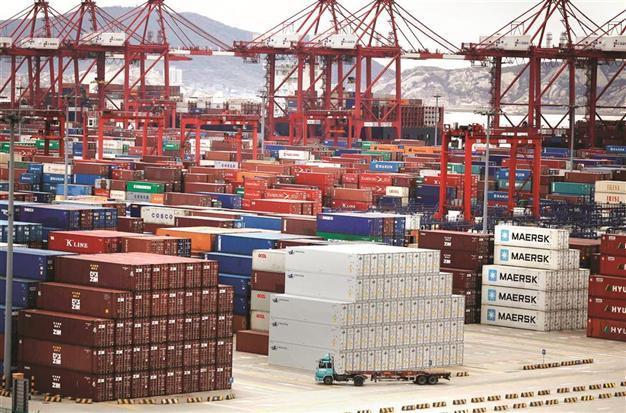China’s September exports fall, trade surplus down 44.7 percent
BEIJING - Agence France-Presse

A container truck drives past the container area at the Yangshan Deep Water Port, south of Shanghai. China’s exports fell 0.3 percent year-on-year to $185.64 billion last month, the data show. REUTERS photo
An unexpected drop in exports led to China’s trade surplus narrowing to a disappointing $15.2 billion in September from $28.6 billion in August, according to the customs figures.Exports fell 0.3 percent year-on-year to $185.64 billion last month, while imports increased 7.4 percent to $170.44 billion, the figures said on Oct. 12. The statistics could signal potential headwind for the world’s number two economy, which relies heavily on global demand for its products.
Exports in August jumped 7.2 percent year-on-year to $190.7 billion. The positive figures had led analysts to point to optimism in China’s economy.
However, the September trade result was worse than expected, with a survey of nine analysts surveyed by Dow Jones Newswires forecasting a trade surplus of $27 billion.
Holidays stall exports
Analysts say China’s national holidays falling in September, along with a strong local currency, could have stalled exports.
“The mid-autumn holidays fell in the middle of the month this year, whereas it fell on the last day of the month in 2012,” ANZ analysts said in a research note.
“The strong RMB has eroded China’s export competitiveness as well,” it added. China’s Mid-Autumn Festival fell from September 19 to September 21 this year, while in 2012 the holiday ran from September 30 into October.
China’s trade performance is a key element of the country’s economic growth figures, the latest of which for the third quarter through September are due for release next Friday. A string of strong data in recent months, including for exports and industrial output, have suggested quarterly growth may accelerate, spurring optimism following a surprise downturn during the first half of the year.
For the first nine months of the year, exports increased eight percent to $1.61 trillion, while imports increased 7.3 percent to $1.45 trillion.
The trade surplus for the period stood at $169.4 billion, up 14.4 percent, the figures showed.
The three-quarterly figures were described as “a trend of low, yet stable growth” by Zheng Yuesheng, an official at China’s General Administration of Customs.
“Trade with the EU and Japan suggested upward momentum, as the trade with the US and ASEAN (the Association of Southeast Asian Nations) continued to climb,” he added.
China, a major driver of the global economy, is coming off its worst annual economic performance since 1999 after gross domestic product (GDP) managed an expansion of just 7.7 percent last year.
Authorities, however, say weaker growth is in line with their desire to shift the country’s economic growth model toward what they see as slower and more sustainable private-led demand rather than previously popular credit-fuelled state-driven investment projects.
The International Monetary Fund (IMF) on Tuesday forecast that China’s economy would grow 7.6 percent this year, while the World Bank said the day before it expects the country to achieve the government’s official target of 7.5 percent.
China’s slowing growth “will affect many other economies, notably the commodity exporters among the emerging market and developing economies”, the Washington-based IMF said in its World Economic Outlook report.
Authorities’ moves to rebalance the economy “may be accompanied by lower medium-term growth than achieved by China in recent decades”, the IMF said.
Earlier this month, the government announced that Chinese manufacturing activity strengthened in September to its highest level in 17 months.
Meanwhile, a closely watched private survey of manufacturing released by British banking giant HSBC in late September for the same month showed a slight gain from August.
















